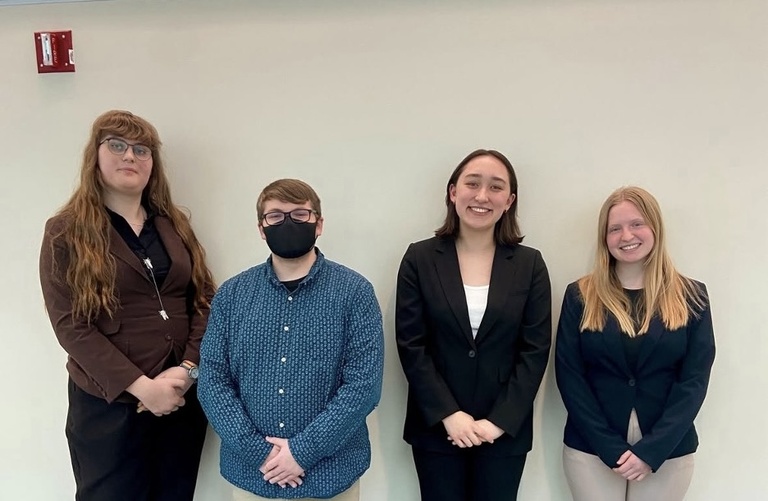Advisor’s Corner
Prof. David Murhammer, Professor and AIChE Student Chapter Advisor
Greetings to Hawkeye Chemical Engineers!! This Spring 2025 issue of our AIChE Student Chapter Newsletter begins with an article about our students’ participation in the College of Engineering Fairway competition. The fairway designed by our students finished 2nd among the 14 participating designs. The next article discusses the 2025 Tinker Process Safety Prize competition won by Klaertje Hesselink, a Chemical Engineering junior. Hesselink and the other participants will present their posters at the 2026 AIChE Spring Meeting in Houston, TX.
Other articles in this issue include discussions of (i) student participation in the College of Engineering Research Open House, (ii) the latest about our K-12 program in which our students conduct experiments with students at a local elementary school, (iii) student attendance and participation at the 2025 AIChE Mid-America Regional Student Conference held at the University of Oklahoma, and (iv) a student research experience. I am proud to announce that a University of Iowa ChemE Jeopardy team won the regional competition for the 5th consecutive year. This team will be competing in the North America competition being held in Boston, MA at the 2025 AIChE Annual Student Conference.
The 2025-26 academic year will be a busy year for the Chemical and Biochemical Engineering Department at the University of Iowa, in that we will be celebrating the 100-year anniversary of chemical engineering at the University of Iowa and will be hosting the 2026 AIChE Mid-America Regional Student Conference. The 100-year anniversary celebration will be held April 9-10, 2026, and the regional conference will follow on April 10-11. More details of these events will be sent to our alumni soon.
Any comments about the newsletter should be sent to me at david-murhammer@uiowa.edu.
Mini-Golf Competition
Gabi Fiedor
Over the course of six weeks, members of AIChE collaborated on a unique mini golf competition hosted by the Engineering Library. The team constructed a fairway inspired by their Chemical Process Safety class, creatively integrating key safety concepts into a fun, hands-on design. The fairway featured a “hazardous waste pond” made from green paper to resemble toxic gas dispersion, a “flammable gas bridge” using water bottles as gas cylinders, and an explosive finale with tissue paper and flickering lights simulating a flash fire. Concepts like HAZOP reviews, hazard diamonds, and explosion risks were brought to life, reinforcing classroom learning in a memorable and engaging way.
Throughout the project, students collaborated closely, sharing ideas, and building the course together. With 14 fairways participating in the competition, AIChE won second place overall, finishing just behind the CBE graduate students and staff. It was a close competition that demonstrated the undergraduates’ strong technical understanding and inventive approach. This event was a fun and creative way to enhance student learning, while working alongside the chemical engineering students! Participants included juniors Eric Hou, Shourya Singh, Klaertje Hesselink, and Ashlee Wergeland, sophomore Cade Machin, and freshman Stephanie Alvarez.
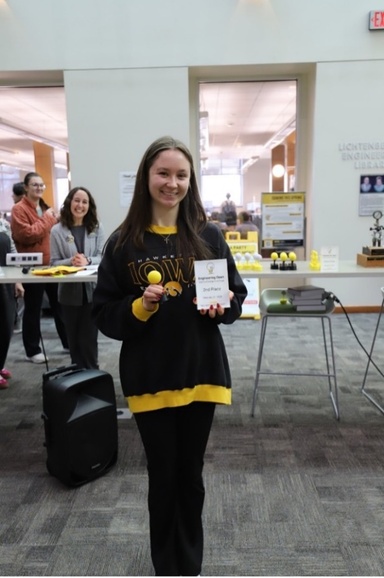
Tinker Process Safety Prize
Klaertje Hesselink
The poster portion of the Tinker Process Safety Competition, sponsored by CBE alumna Sharon Tinker, was held on Friday, February 21, 2025. The competition is aimed towards students who have completed the Chemical Process Safety course, taught by Professor Murhammer, to research a real-world incident from a U.S. Chemical Safety and Hazard Investigation Board (CSB) report and present their findings through a report and poster. Founded by Tinker in 2019, the competition is now in its sixth year. Tinker is a member of Iowa’s Distinguished Engineering Alumni Academy and a member of the Advisory Board and built a remarkable career in chemical process safety at ExxonMobil. Even in retirement, she remains dedicated to promoting safety by sponsoring this competition. Each year, the first-place winner is awarded $1,000, while each runner-up receives $500.
This year, four students participated in the competition. The competition consisted of two components, a written report analyzing a Chemical Safety and Hazard Investigation Board (CSB) incident, and a poster presentation based on the selected incident. The final score was equally weighted between the quality of the written report and the judges’ evaluations of the poster presentation. The papers and posters were evaluated by Sharon Tinker, several alumni judges, and last year’s competition winner and runners-up. Following the presentations, the judges convened to select the winners.
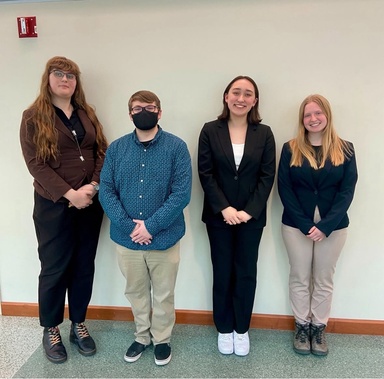
I was awarded first place for my report and poster on BP Texas City Refinery Explosions. The three runners-up were Anna Blobaum, Rhea Fisch, and Alex Rohm. The BP Texas City Refinery explosion occurred in Texas City, Texas, on March 23, 2005, during the startup of the isomerization (ISOM) unit. At 1:20 p.m., a series of explosions and fires broke out, killing 15 people and injuring more than 180 others. The incident began when the raffinate splitter tower was overfilled with liquid hydrocarbons during startup. As pressure built up, the relief devices activated, sending the flammable liquid into a blowdown drum that lacked a flare system. The liquid erupted from the drum and formed a large vapor cloud which was ignited when a nearby truck backfired.
The U.S. Chemical Safety and Hazard Investigation Board (CSB) launched an investigation into the incident, which revealed systemic safety and organizational failures at both the refinery and BP’s corporate level. Despite many warning signs and hazardous conditions at the site, BP leadership failed to intervene. The company prioritized cost-cutting and production goals over safety and lacked a process safety culture. The investigation also found that critical safety information was poorly communicated during shift changes, further contributing to the disaster.
BP relied heavily on personal injury rates as a measure of safety, which created a false sense of security and diverted attention from underlying process safety risks. The CSB found that BP’s Board of Directors failed to provide proper oversight or accountability for safety performance, and that no dedicated board member was responsible for safety management review.
Participating in the Tinker Process Safety Competition gave me a great opportunity to apply and expand my knowledge of process safety in the chemical industry. This competition was an exciting way to strengthen my written and oral communication skills in a technical setting. I really enjoyed being part of the experience and learned a great deal about the chemical engineering industry. I highly encourage next year’s Chemical Process Safety students to take part in this rewarding experience.
Research Open House
Anne Wu
On Thursday April 24th, the College of Engineering hosted its annual Spring Research Open House. This year, it featured 75 different posters from all the different disciplines, with both undergraduate and graduate students presenting. The open house is a great time for students to display their research and gain valuable experience talking to judges. It also allows them to sharpen their improvisational speaking skills. To me, it has always seemed less intimidating than the undergraduate research festivals. I think that it’s a wonderful opportunity for first-time presenters to participate in. The open house is a welcoming environment where students can gain confidence and receive meaningful feedback on their work.
If you aren’t presenting, it’s still definitely worthwhile to attend, even if only for a short time. Presenters always appreciate someone to talk to, and it allows you to truly experience everything the college has to offer. No matter the level of knowledge you have in a topic, there’s always something for everyone to learn. Stopping by a few posters and asking questions not only supports your peers but can spark new interests or ideas for your own future projects. Attending also helps build a stronger sense of community, as you get to connect with fellow students, professors, and more.
Finally, congratulations to some of our very own AIChE members who won awards! John Syata was second in the People’s Choice Awards and Colin Houts won the undergraduate CBE departmental award!
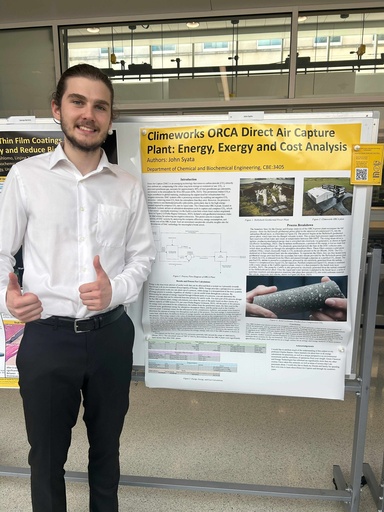
Central Elementary K-12 Visits
Anna Blobaum
Our K-12 outreach had a successful semester this spring! K-12 coordinators and volunteers visited local elementary schools three times throughout the semester with some new faces and new experiments to bring chemistry to kids.
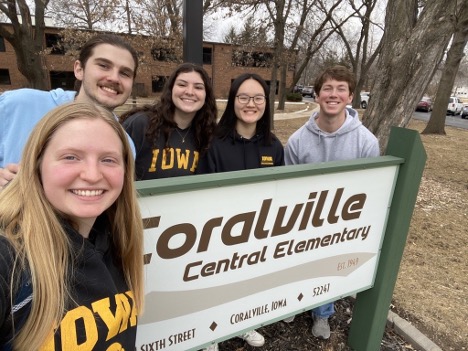
There were two visits this semester to a familiar fourth-grade classroom at Coralville Central Elementary School. This class has been a pleasure to visit, with smart and eager students!
To tie in with the cold and icy weather early this year, our first experiment with the class explored how salt is used to keep roads safe in the winter. Several types of salts lower the freezing point of water when their ions surround water molecules and break up the crystalline structure of ice, making lower temperatures necessary for water molecules to find each other again and freeze.
This process can be seen with a simple experiment: when salt is sprinkled atop ice in cold water, the ice starts to melt. At this step, we placed string across the ice cubes. If the water is cold enough, the ice will re-freeze around the string, and the ice cubes can be lifted by the string! Students at Coralville loved “fishing” for ice and easily connected the experiment to the salt and ice melt we place on roads and sidewalks in the wintertime.
Our second experiment was centered around acid-base reactions and used baking soda and vinegar to give an example of how different acid-base combinations are used to give some of our favorite baked goods the textures we love. Each team of students received a bottle, a balloon, baking soda, and the objective to inflate the balloon using a chemical reaction. Next, each team discussed if they wanted to combine their baking soda with water, oil, or vinegar in their quest to inflate the balloon.
After examining a chocolate cake recipe as a class, everyone knew that all three of these ingredients are present in some recipes that rise when cooked. This helped create a variety of ingredient combinations across groups. In the end, of course, tables that chose vinegar (and their neighbors) watched with glee as balloons filled with carbon dioxide produced by the reaction between baking soda and vinegar.
Nine of our students also participated in the STEM night at West Liberty Elementary School on April 17th. The experiment demonstrating the effect of salt on ice was repeated at this event.
As in every semester, our K-12 events have been a fun and rewarding way for AIChE members to get involved and give back to the community. Looking to next semester, we hope to visit our favorite classrooms as well as reach out and find new ones. We also hope to enter the national AIChE K-12 Competition, in which AIChE chapters form original K-12 modules and present them at the national conference.
Spring AIChE Conference
Natalie Schlichte
The Mid-America AIChE regional conference was at the University of Oklahoma this year, and our University of Iowa chapter had many attendees. We drove about ten hours from Iowa City to Norman, Oklahoma. To start off the day, there was the ChemE car competition, where teams competed to race cars that were powered by chemical energy. Although the University of Iowa didn’t have a car this year, it was still a lot of fun to watch, and we look forward to (hopefully) having one next year! The next event was the research presentations, at which we had a lot of our own students showing off their hard work.
The biggest event of the night was the ChemE Jeopardy event, where the teams from Iowa included Maxwell’s Silver Hammer (Liam Horan, Colin Houts, Eric Hou, Rhea Fisch), DaSh of Disaster (Don Roberts, Alex Rohm, Sydney Schulte, Henry Benton), and Caleb’s Nephews (Caleb Coulthard, Matt Kawa, Cade Machin, Fahim Rafi). Maxwell’s Silver Hammer was the team to come out on top, where they will represent the University of Iowa well in the AIChE nationals in the fall!
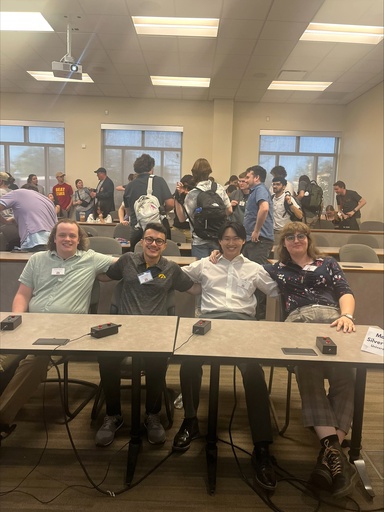
To end the 2025 regional conference, there was a banquet where research awards were presented along with the awards for ChemE car and ChemE Jeopardy. The University of Iowa had a great time in Oklahoma, and we look forward to hosting the regionals next spring!
Research Spotlight
Rhea Fisch
Modern industry, research, and consumer products use copious quantities of plastic for disposable goods because of its low production cost and high workability. However, the polymers used to make these goods are not sustainable; most are made from petroleum, which produces heavy CO2 emissions and extensive waste which is difficult to safely destroy. An alternative to this is bioplastics, which are typically made as fermentation products from bacterial cultures, and which my research group and I study in Dr. Seo’s lab.
While there are several candidates for viable bioplastics, I am working on a project studying production of polyhydroxyalkanoates (PHAs) in a species of bacteria called Cupriavidus necator. This bacterium has been studied for its PHA production for decades, but there have historically been issues with its metabolism, as wild strains do not metabolize glucose, the most common bacterial growth nutrient in industry.
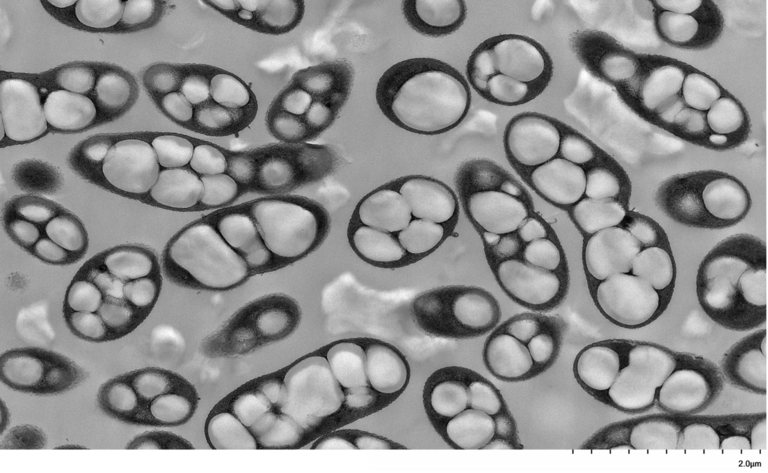
Through genetic engineering, we hope to produce a strain of C. necator which can be used to profitably replace petrochemical single-use plastics with PHAs. Beyond this aim, however, there is untapped biodiversity found in the wild strains of C. necator. Most past research on the bacterium has been conducted in the primary strain, 428, however there are several strains into which very little research has been conducted. I spent this past semester quantifying the growth rates of each in a fructose medium, from which I identified a few strains which are promising. Elizabeth Walker, a graduate student in the CBE department, has also identified those strains as promising targets of genetic modification.
Over the summer and my senior year, I hope to work further on analyzing the biodiversity of C. necator, by investigating polymer chain length, PHA yield, ideal medium composition, and looking at the microbes themselves under an electron microscope. I had the pleasure of using a transmission electron microscope to look at C. necator 428, and I am very excited to reproduce this with the other strains I am studying.
Acknowledgements
Thank you to the AIChE Officers for their hard work and contributing efforts to make our AIChE Student Chapter a successful organization!
President: Gabi Fiedor
Vice President: Klaertje Hesselink
Secretary: Alex Rohm
Treasurer: Ashlee Wergeland
Newsletter Editor: Rhea Fisch
Webmaster: Isabella Warner
Historian: Anne Wu
Social Chair: Isabelle Pfeiffer
K-12 Program Coordinators: Anna Blobaum, John Syata, and TJ Kimm
Volunteer Chair: Eric Hou
Advisor: Professor David Murhammer
Editor-In-Chief Rhea Fisch would also like to thank the following people for their support and contributions to the Spring 2025 AIChE Student Chapter Newsletter:
Faculty Advisor: Professor David Murhammer
Contributors: Professor David Murhammer, Gabi Fiedor, Klaertje Hesselink, Anne Wu, anna Blobaum, Natalie Schlichte, and Rhea Fisch
Your help is much appreciated!


